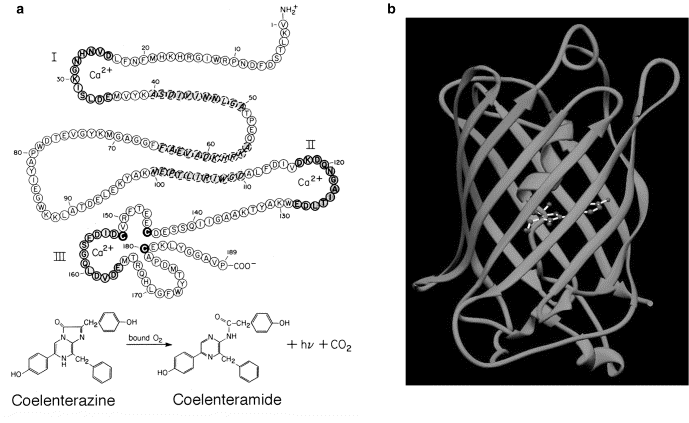Bioluminescence In Jellyfish
Biology 342 Fall 2010
Michelle Ichikawa
Mechanism
How Do Jellyfish Produce Light?
The Basic Reaction
All bioluminescence reactions involve three major components- a luciferin, a luciferase, and oxygen. The luciferin is the chemical that produces the light, and the luciferase is the enzyme that catalyzes the reaction. When they react, luciferase catalyzes the oxidation of the luciferin to produce an unstable excited intermediate. As this decays to its ground state, light is emitted and the product, oxyluciferin, is generated. This reaction only produces light once, and consequently more luciferin must be brought into the organism.
More Specifically...
There are many different luciferins used by marine mammals to make light. The most common, and the one used by ctenophores and cnidarians, is colenterazine. In A. victoria, a jellyfish found mainly in Friday Harbor, bioluminescence stems from a photoprotein found in specialized photocytes in the umbrella of the organism. The photoprotein, aequorin, is a stable intermediate complex of colenterazine bound to the catalyzing apoprotein (apo-aequorin) with oxygen. As a result of this stabilization, decay of these photoprotein intermediates and emission of light can be controlled by the protein. Binding of calcium ions to the protein triggers the oxidation of colenterazine to colenteramide, and the emission of blue light. This complex is often referred to as the Blue Fluorescent Protein, BFP (Kendall and Badminton).

(a)Primary structure of apo-aquorin. Sequence illustrates Ca2+binding sites. Oxidation of colenterazine to colenteramide is triggered with Ca2+ binds to the protein, and light is produced. (b) Crystal structure of a GFP mutant (Kendall and Badminton).
Then Why Do Some Jellies Appear Green?
The second step in some cnidarian luminescence is the transfer of energy to the green fluorescent protein, GFP, which emits green light through the process of fluorescence. Fluorescence differs from bioluminescence in that an external source of light is absorbed and then remitted with a change of color, rather than created. The energy generated from the oxidation of aequorin causes the excitation of GFP, and results in the emission of green light (Ward, et al). The resulting color of the jellyfish then appears to be blue- green, due to both colors of light being emitted. It appears that not all cnidarians contain GFP, as previously thought, and current research reports that closer to ~10% of luminescent species contain the protein. The presence of GFP is extremely common in jellies occupying shallower waters. (Haddock and Case 1999)